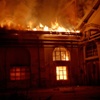
NFPA: Home Fires Account for 92 Percent of Structure Fire Deaths
According to a new National Fire Protection Association (NFPA) study called Home Structure Fires, home fires account for 92 percent of fire deaths that occur in structures. These fires cause an average of 2,840 civilian deaths each year.
“This study strongly underscores the need to aggressively work to reduce the number of home fires in this country in order to save lives from fire,” said Lorraine Carli, vice president of communications for NFPA.
During the period of 2003-2007, U.S. fire departments responded to approximately 380,000 home fires a year. These fires not only caused a large number of civilian deaths, they also caused an average of 13,160 reported civilian fire injuries and $6.4 billion in direct property damage.
From 2003-2007, smoking materials caused the largest number of fire deaths. Heating equipment was the second leading cause of home fires and home fire deaths.
The leading cause of home structure fires, civilian fire injuries, and unreported fires continues to be cooking equipment. Forty-one percent of home fires started in the kitchen area and caused 15 percent of the home fire deaths and 36 percent of the reported fire injuries.
Other key findings include:
- Reported home fires peaked around dinner hours of 5 to 8 p.m.
- Only 20 percent of the reported home fires occurred between 11 p.m. and 7 a.m., however 52 percent of home fire deaths resulted from fires reported during these hours.
- Thirty percent of reported home structure fires and 38 percent of home fire deaths occurred in the quarter including December, January, and February.
- Reported apartment fires were more likely to start in the kitchen than fires in one- and two-family homes.
- The two leading items first ignited in home fire deaths are upholstered furniture in 21 percent of home fire deaths, followed by mattress and bedding in 13 percent of the deaths.
Properly installed and maintained fire protection can prevent most fire deaths. Forty percent of fatal home fire injuries occurred in properties where no smoke alarms were present. Home fire sprinklers can also help, as the death rate per 1,000 reported home fires was 83 percent lower when wet pipe sprinkler systems were present, compared to reported home fires without automatic extinguishing equipment.
“Smoke alarms have been a key factor in significantly reducing the fire death problem since their widespread use beginning in the ‘70s,” Carli said. "The move to require home fire sprinklers in new homes will be the next step forward in fire protection.”
NFPA offers these safety tips to prevent home structure fires from occurring:
- Keep anything that can catch fire—oven mitts, wooden utensils, food packaging, towels or curtains—away from the stovetop.
- Keep anything that can burn, such as paper, bedding, or furniture, at least three feet away from heating equipment and have a three-foot “kid-free zone” around stoves, open fires, and space heaters.
- Remember to turn off portable heaters when leaving the room or going to bed.
- Smoke alarm accessories are available for people who are hard of hearing. These accessories activate from the sound of traditional smoke alarms and produce a complex low frequency alarm signal, more effective at waking those with mild to severe hearing loss.
For the complete list of safety tips, visit www.nfpa.org/safetytips.